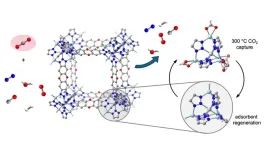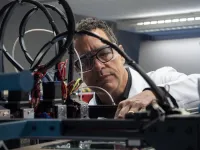(Press-News.org) Industrial plants, such as those that make cement or steel, emit copious amounts of carbon dioxide, a potent greenhouse gas, but the exhaust is too hot for state-of-the-art carbon removal technology. Lots of energy and water are needed to cool the exhaust streams, a requirement that has limited adoption of CO2 capture in some of the most polluting industries.
Now, chemists at the University of California, Berkeley, have discovered that a porous material can act like a sponge to capture CO2 at temperatures close to those of many industrial exhaust streams. The material — a type of metal-organic framework, or MOF — will be described in a paper to be published in the Nov. 15 print edition of the journal Science.
The dominant method for capturing carbon from power or industrial plant emissions employs liquid amines to absorb CO2, but the reaction only works efficiently at temperatures between 40 and 60 C (100–140 F). Cement manufacturing and steelmaking plants produce exhaust that exceeds 200 C (400 F), and some industrial exhaust approaches 500 C (930 F). New materials that are now being piloted, including a subclass of MOFs with added amines, break down at temperatures above 150 C (300 F) or work far less efficiently.
"A costly infrastructure is necessary to take these hot gas streams and cool them to the appropriate temperatures for existing carbon capture technologies to work," said UC Berkeley postdoctoral fellow Kurtis Carsch, one of two co-first authors of the paper. "Our discovery is poised to change how scientists think about carbon capture. We've found that a MOF can capture carbon dioxide at unprecedentedly high temperatures — temperatures that are relevant for many CO2 emitting processes. This was something that was previously not considered as possible for a porous material."
"Our work moves away from the prevalent study of amine-based carbon capture systems and demonstrates a new mechanism for carbon capture in a MOF that enables high temperature operation," said UC Berkeley graduate student and co-first author Rachel Rohde.
Like all MOFs, the material features a porous, crystalline array of metal ions and organic linkers, with an internal area equivalent to about six football fields per tablespoon — a huge area for adsorbing gases.
"As a result of their unique structures, MOFs have a high density of sites where you can capture and release CO2 under the appropriate conditions," Carsch said.
Under simulated conditions, the researchers showed that this new type of MOF can capture hot CO2 at concentrations relevant to the exhaust streams of cement and steel manufacturing plants, which average 20% to 30% CO2, as well as less concentrated emissions from natural gas power plants, which contain about 4% CO2.
Removing CO2 from industrial and power plant emissions, after which it is either stored underground or used to make fuels or other value-added chemicals, is a key strategy for reducing greenhouse gases that are warming Earth and altering the climate globally. While renewable energy sources are already reducing the need for CO2-emitting, fossil fuel-burning power plants, industrial plants that make intense use of fossil fuels are harder to make sustainable, so flue gas capture is essential.
"We need to start thinking about the CO2 emissions from industries, like making steel and making cement, that are hard to decarbonize, because it's likely that they're still going to be emitting CO2, even as our energy infrastructure shifts more toward renewables," Rohde said.
Moving from amines to metal hydrides
Rohde and Carsch conduct research in the lab of Jeffrey Long, UC Berkeley professor of chemistry, chemical and biomolecular engineering, and of materials science and engineering. Long has been conducting research on CO2-adsorbing MOFs for more than a decade. His lab created a promising material in 2015 that was further developed by Long's startup company, Mosaic Materials, which in 2022 was acquired by the energy technology company Baker Hughes. This material features amines that capture the CO2; next-generation variants are being tested as alternatives to aqueous amines for CO2 capture in pilot-scale plants, and as a way to capture CO2 directly from ambient air.
But those MOFs, like other porous adsorbents, are ineffective at the elevated temperatures associated with many flue gases, Carsch said.
Amine-based adsorbents, like those developed by Long, have been the focus of carbon capture research for decades. The MOF studied by Rohde, Carsch, Long and their colleagues instead features pores decorated with zinc hydride sites, which also bind CO2. These sites turned out to be surprisingly stable, Rohde said.
"Molecular metal hydrides can be reactive and have low stability," Rohde said. "This material is highly stable and does something called deep carbon capture, which means it can capture 90% or more of the CO2 that it comes into contact with, which is really what you need for point-source capture. And it has CO2 capacities comparable to the amine-appended MOFs, though at much higher temperatures."
Once the MOF is filled with CO2, the CO2 can be removed, or desorbed, by lowering the partial pressure of CO2, either by flushing with a different gas or putting it in a vacuum. The MOF is then ready to be reused for another adsorption cycle.
"Because entropy favors having molecules like CO2 in the gas phase more and more with increasing temperature, it was generally thought to be impossible to capture such molecules with a porous solid at temperatures above 200 C," Long said. "This work shows that with the right functionality — here, zinc hydride sites — rapid, reversible, high-capacity capture of CO2 can indeed be accomplished at high temperatures such as 300 C."
Rohde, Long and their colleagues are exploring variants of this metal hydride MOF to see what other gases they can adsorb, and also modifications that will allow such materials to adsorb even more CO2.
"We’re fortunate to have made this discovery, which has opened up new directions in separation science focused on the design of functional adsorbents that can operate at high temperatures,” said Carsch, who has taken a faculty position in the Department of Chemistry at The University of Texas at Austin. "There’s a tremendous number of ways we can tune the metal ion and linker in MOFs, such that it may be possible to rationally design such adsorbents for other high-temperature gas separation processes relevant to industry and sustainability.”
Other authors of the paper are Jeffrey Reimer, a UC Berkeley professor of chemical and biomolecular engineering, whose lab provided evidence from NMR spectroscopy to support the unique mechanism of CO2 capture by the zinc hydride sites in the MOF; Craig Brown of the National Institute of Standards and Technology in Gaithersburg, Maryland, who also provided critical structural data supporting the proposed mechanism; and UC Berkeley chemistry professor Martin Head-Gordon, whose lab provided a computational understanding of the high-temperature CO2 capture behavior. Other UC Berkeley authors include Andrew Minor, a UC Berkeley professor of materials science and engineering, and Matthew Dods, Henry Jiang, Alexandra McIsaac, Hyunchul Kwon, Sarah Karstens, Yang Wang, Adrian Huang, Jordan Taylor, Yuto Yabuuchi, Nikolay Tkachenko, Katie Meihaus, Hiroyasu Furukawa and Kaitlyn Engler.
Rohde was supported by a graduate fellowship from the National Aeronautics and Space Administration, while Carsch was supported by a postdoctoral fellowship from the Arnold O. Beckman Foundation.
END
Breakthrough in capturing 'hot' CO2 from industrial exhaust
A metal-organic framework, or MOF, is capable of capturing CO2 at extreme temperatures
2024-11-14
ELSE PRESS RELEASES FROM THIS DATE:
New discovery enables gene therapy for muscular dystrophies, other disorders
2024-11-14
Gene therapy can effectively treat various diseases, but for some debilitating conditions like muscular dystrophies there is a big problem: size. The genes that are dysfunctional in muscular dystrophies are often extremely large, and current delivery methods can’t courier such substantial genetic loads into the body. A new technology, dubbed “StitchR,” surmounts this obstacle by delivering two halves of a gene separately; once in a cell, both DNA segments generate messenger RNAs (mRNAs) that join seamlessly together to restore expression of a protein that is missing or inactive in disease.
Published in ...
Anti-anxiety and hallucination-like effects of psychedelics mediated by distinct neural circuits
2024-11-14
New research suggests that it could be possible to separate treatment from hallucinations when developing new drugs based on psychedelics. The anti-anxiety andhallucination-inducing qualities of psychedelic drugs work through different neural circuits, according to research using a mouse model. The work is published Nov. 15 in Science.
The research shows that decoupling the beneficial effects of psychedelics from their hallucinogenic effects isn’t just a matter of chemical compound design. It’s a matter of targeted neural circuitry.
“In the past, we did this using chemistry by making new compounds, but here we focused on identifying the circuits responsible ...
How do microbiomes influence the study of life?
2024-11-14
UNIVERSITY PARK, Pa. — Microorganisms — bacteria, viruses and other tiny life forms — may drive biological variation in visible life as much, if not more, than genetic mutations, creating new lineages and even new species of animals and plants, according to Seth Bordenstein, director of Penn State’s One Health Microbiome Center, professor of biology and entomology, and the Dorothy Foehr Huck and J. Lloyd Huck Endowed Chair in Microbiome Sciences. Bordenstein and 21 other scientists from around the world published a paper in the leading journal Science, summarizing research that they said drives a deeper understanding of biological ...
Plant roots change their growth pattern during ‘puberty’
2024-11-14
Ghent, November 15, 2024 – Understanding how roots grow can help us develop plants that, for example, are more resistant to drought. Research by Prof. Bert De Rybel’s team (VIB-UGent), in collaboration with the VIB Screening Core and Ghent University, uncovers how roots go through a puberty phase, which could have important implications for developing climate-resilient agriculture. Their work appears in Science.
Plant puberty
Plants, like all living organisms, transition through various developmental stages, starting as a seed, becoming a shoot, and eventually a full-grown, fertile plant. They even go through a sort of ‘puberty’ ...
Study outlines key role of national and EU policy to control emissions from German hydrogen economy
2024-11-14
Hydrogen is set to play an important role in a future low-carbon economy. However, the hydrogen value chain comes with a set of emissions challenges that need to be addressed for hydrogen deployment to help achieve climate goals. A study prepared by the Research Institute for Sustainability – Helmholtz Centre Potsdam (RIFS) with support from Environmental Defense Fund Europe evaluates the potential impact of climate-warming emissions in Germany’s future hydrogen economy and provides recommendations for German and EU policymakers on how to avoid them.
There are hopes that hydrogen can become a carbon neutral alternative to fossil ...
Beloved Disney classics convey an idealized image of fatherhood
2024-11-14
For decades, Disney animations have shaped perceptions of family relationships and gender roles. Although much focus has traditionally been on princesses and female characters, a new study shifts attention to fatherhood and the evolving ideals of masculinity.
"In the history of Disney films, female characters and princess imagery have been widely analyzed, yet the role of masculinity has been explored far less. My research aims to deepen our understanding of the male ideals Disney has constructed and how they reflect ...
Sensitive ceramics for soft robotics
2024-11-14
Most people think of coffee cups, bathroom tiles or flower pots when they hear the word "ceramic". Not so Frank Clemens. For the research group leader in Empa's Laboratory for High-Performance Ceramics, ceramics can conduct electricity, be intelligent, and even feel. Together with his team, Clemens is developing soft sensor materials based on ceramics. Such sensors can "feel" temperature, strain, pressure or humidity, for instance, which makes them interesting for use in medicine, but also in the field of soft robotics.
Soft ceramics – how is that supposed to work? Materials ...
Trends in hospitalizations and liver transplants associated with alcohol-induced liver disease
2024-11-14
About The Study: This study found significant rate increases for alcohol-induced liver disease-related hospitalizations and liver transplants across sex and age groups between 2005 and 2021. Although older males had the highest absolute increases, the greatest relative increases occurred in younger individuals, particularly females.
Corresponding Author: To contact the corresponding author, Michele Molinari, MD, MSc, email molinarim@upmc.edu.
To access the embargoed study: Visit our For The Media website at this link ...
Spinal cord stimulation vs medical management for chronic back and leg pain
2024-11-14
About The Study: This systematic review and network meta-analysis found that spinal cord stimulation therapies for treatment of chronic pain in back and/or lower extremities were associated with greater improvements in pain compared with conventional medical management. These findings highlight the potential of spinal cord stimulation therapies as an effective and valuable option in chronic pain management.
Corresponding Author: To contact the corresponding author, Konstantinos Soulanis, M.Sc., email konstantinos.soulanis@iqvia.com.
To access ...
Engineered receptors help the immune system home in on cancer
2024-11-14
Most cancer treatments – from chemotherapies to engineered immune cells – have a host of side effects, in large part because they affect healthy cells in the body at the same time as targeting tumor cells. For the same reason, designing new cancer drugs can be challenging due to the molecular similarities between tumor cells and healthy cells.
Now, UC San Francisco researchers have designed highly customizable biological sensors which can ensure that engineered cells are only activated in certain environments – such as the vicinity of a tumor. This could yield cancer therapies ...
LAST 30 PRESS RELEASES:
Sleeping in on weekends may help boost teens’ mental health
Study: Teens use cellphones for an hour a day at school
After more than two years of war, Palestinian children are hungry, denied education and “like the living dead”
The untold story of life with Prader-Willi syndrome - according to the siblings who live it
How the parasite that ‘gave up sex’ found more hosts – and why its victory won’t last
When is it time to jump? The boiling frog problem of AI use in physics education
Twitter data reveals partisan divide in understanding why pollen season's getting worse
AI is quick but risky for updating old software
Revolutionizing biosecurity: new multi-omics framework to transform invasive species management
From ancient herb to modern medicine: new review unveils the multi-targeted healing potential of Borago officinalis
Building a global scientific community: Biological Diversity Journal announces dual recruitment of Editorial Board and Youth Editorial Board members
Microbes that break down antibiotics help protect ecosystems under drug pollution
Smart biochar that remembers pollutants offers a new way to clean water and recycle biomass
Rice genes matter more than domestication in shaping plant microbiomes
Ticking time bomb: Some farmers report as many as 70 tick encounters over a 6-month period
Turning garden and crop waste into plastics
Scientists discover ‘platypus galaxies’ in the early universe
Seeing thyroid cancer in a new light: when AI meets label-free imaging in the operating room
Neutrophil-to-lymphocyte ratio may aid risk stratification in depressive disorder
2026 Seismological Society of America Annual Meeting
AI-powered ECG analysis offers promising path for early detection of chronic obstructive pulmonary disease, says Mount Sinai researchers
GIMM uncovers flaws in lab-grown heart cells and paves the way for improved treatments
Cracking the evolutionary code of sleep
Medications could help the aging brain cope with surgery, memory impairment
Back pain linked to worse sleep years later in men over 65, according to study
CDC urges ‘shared decision-making’ on some childhood vaccines; many unclear about what that means
New research finds that an ‘equal treatment’ approach to economic opportunity advertising can backfire
Researchers create shape-shifting, self-navigating microparticles
Science army mobilizes to map US soil microbiome
Researchers develop new tools to turn grain crops into biosensors
[Press-News.org] Breakthrough in capturing 'hot' CO2 from industrial exhaustA metal-organic framework, or MOF, is capable of capturing CO2 at extreme temperatures




